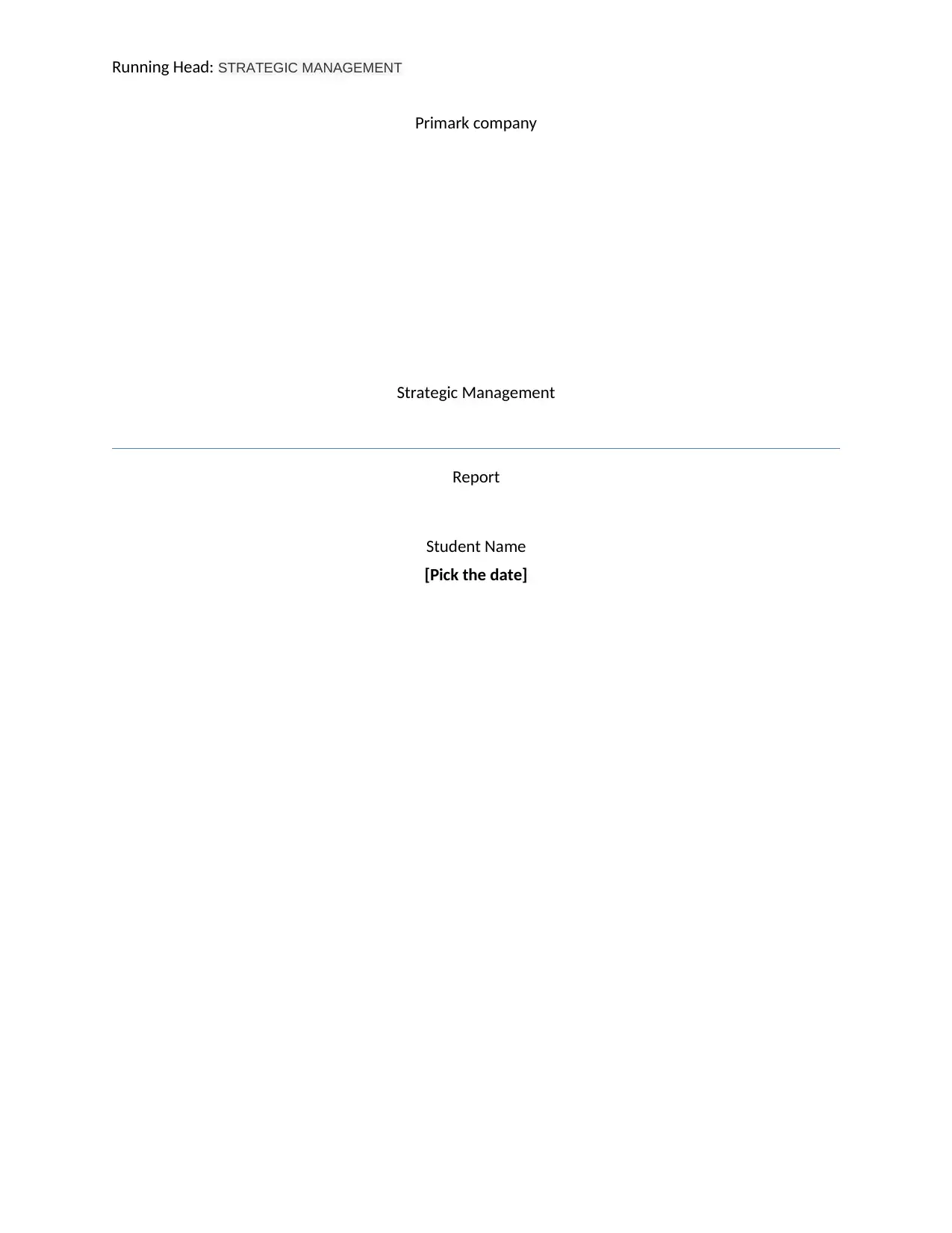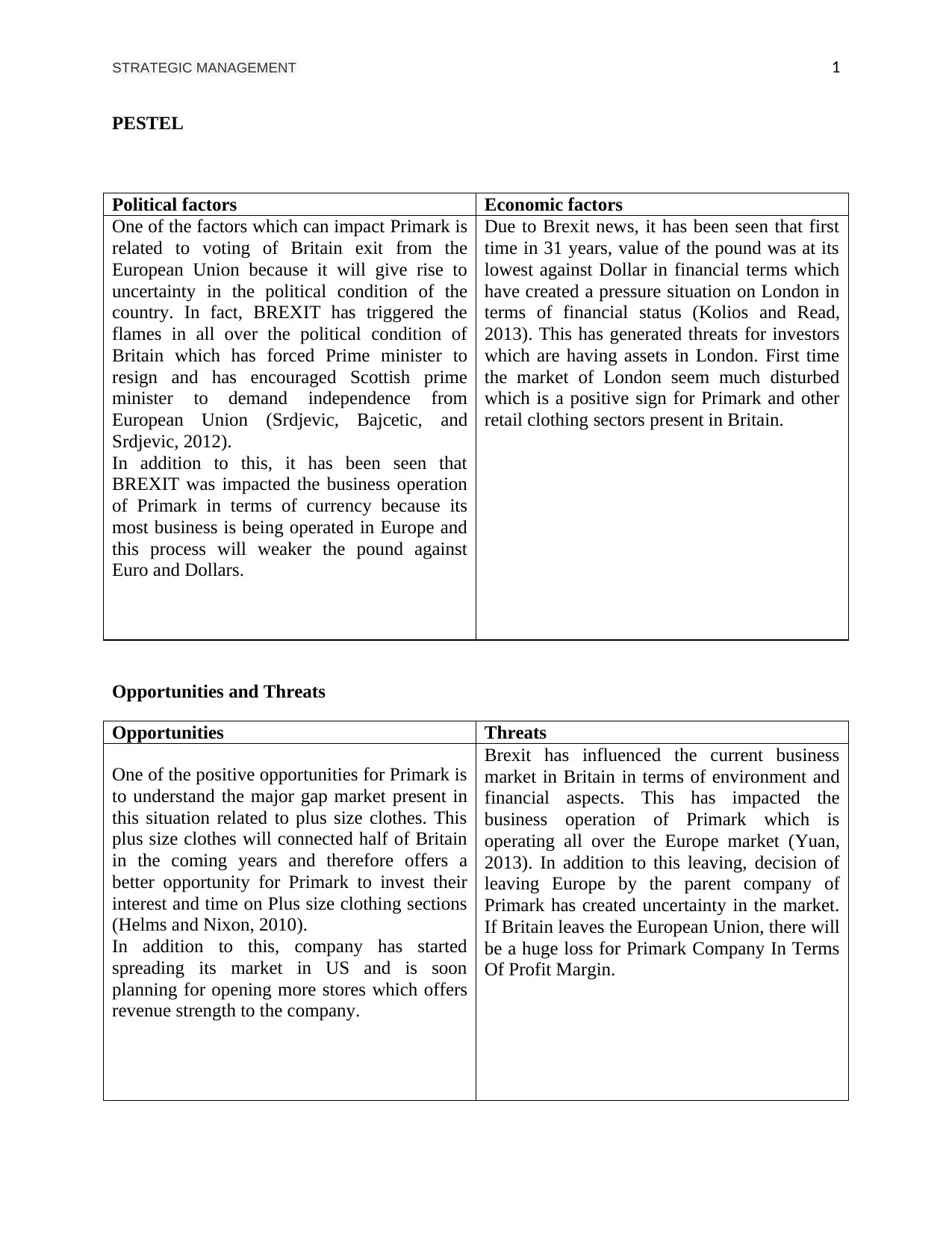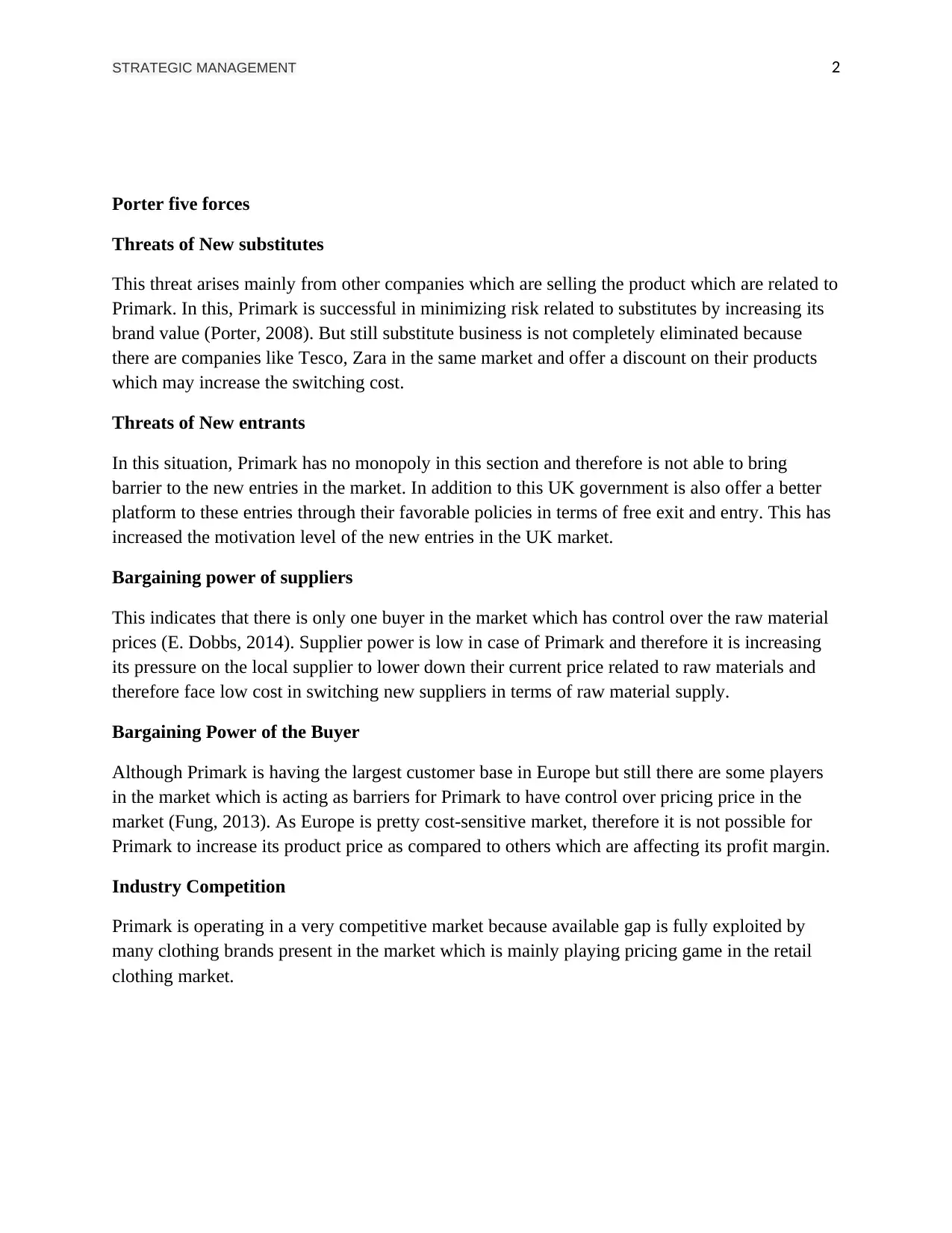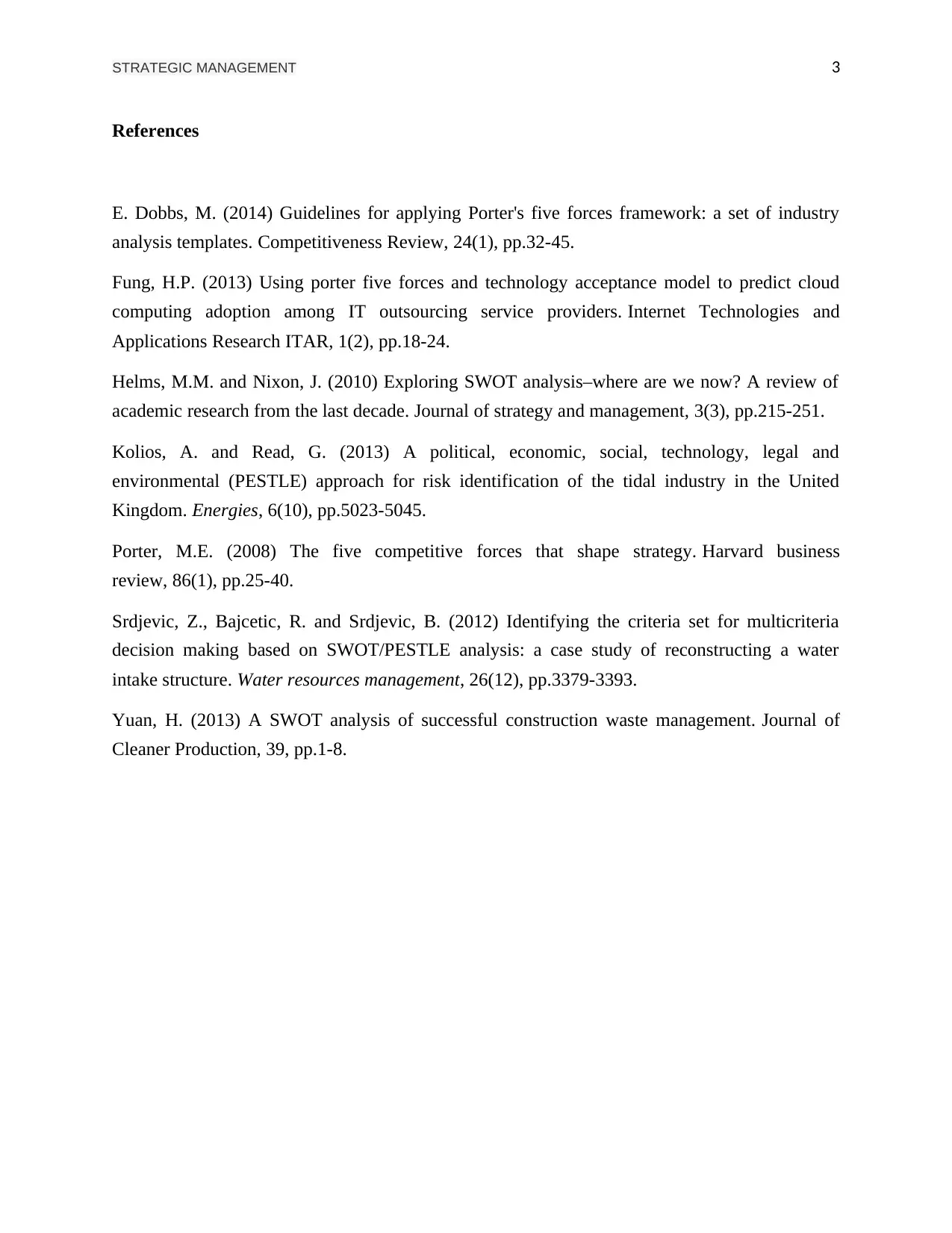Strategic Management - Primark Company
VerifiedAdded on 2023/03/17
|4
|1028
|66
AI Summary
This report discusses the impact of political and economic factors, opportunities and threats, and Porter's five forces on Primark Company's strategic management.
Contribute Materials
Your contribution can guide someone’s learning journey. Share your
documents today.

Running Head: STRATEGIC MANAGEMENT
Primark company
Strategic Management
Report
Student Name
[Pick the date]
Primark company
Strategic Management
Report
Student Name
[Pick the date]
Secure Best Marks with AI Grader
Need help grading? Try our AI Grader for instant feedback on your assignments.

STRATEGIC MANAGEMENT 1
PESTEL
Political factors Economic factors
One of the factors which can impact Primark is
related to voting of Britain exit from the
European Union because it will give rise to
uncertainty in the political condition of the
country. In fact, BREXIT has triggered the
flames in all over the political condition of
Britain which has forced Prime minister to
resign and has encouraged Scottish prime
minister to demand independence from
European Union (Srdjevic, Bajcetic, and
Srdjevic, 2012).
In addition to this, it has been seen that
BREXIT was impacted the business operation
of Primark in terms of currency because its
most business is being operated in Europe and
this process will weaker the pound against
Euro and Dollars.
Due to Brexit news, it has been seen that first
time in 31 years, value of the pound was at its
lowest against Dollar in financial terms which
have created a pressure situation on London in
terms of financial status (Kolios and Read,
2013). This has generated threats for investors
which are having assets in London. First time
the market of London seem much disturbed
which is a positive sign for Primark and other
retail clothing sectors present in Britain.
Opportunities and Threats
Opportunities Threats
One of the positive opportunities for Primark is
to understand the major gap market present in
this situation related to plus size clothes. This
plus size clothes will connected half of Britain
in the coming years and therefore offers a
better opportunity for Primark to invest their
interest and time on Plus size clothing sections
(Helms and Nixon, 2010).
In addition to this, company has started
spreading its market in US and is soon
planning for opening more stores which offers
revenue strength to the company.
Brexit has influenced the current business
market in Britain in terms of environment and
financial aspects. This has impacted the
business operation of Primark which is
operating all over the Europe market (Yuan,
2013). In addition to this leaving, decision of
leaving Europe by the parent company of
Primark has created uncertainty in the market.
If Britain leaves the European Union, there will
be a huge loss for Primark Company In Terms
Of Profit Margin.
PESTEL
Political factors Economic factors
One of the factors which can impact Primark is
related to voting of Britain exit from the
European Union because it will give rise to
uncertainty in the political condition of the
country. In fact, BREXIT has triggered the
flames in all over the political condition of
Britain which has forced Prime minister to
resign and has encouraged Scottish prime
minister to demand independence from
European Union (Srdjevic, Bajcetic, and
Srdjevic, 2012).
In addition to this, it has been seen that
BREXIT was impacted the business operation
of Primark in terms of currency because its
most business is being operated in Europe and
this process will weaker the pound against
Euro and Dollars.
Due to Brexit news, it has been seen that first
time in 31 years, value of the pound was at its
lowest against Dollar in financial terms which
have created a pressure situation on London in
terms of financial status (Kolios and Read,
2013). This has generated threats for investors
which are having assets in London. First time
the market of London seem much disturbed
which is a positive sign for Primark and other
retail clothing sectors present in Britain.
Opportunities and Threats
Opportunities Threats
One of the positive opportunities for Primark is
to understand the major gap market present in
this situation related to plus size clothes. This
plus size clothes will connected half of Britain
in the coming years and therefore offers a
better opportunity for Primark to invest their
interest and time on Plus size clothing sections
(Helms and Nixon, 2010).
In addition to this, company has started
spreading its market in US and is soon
planning for opening more stores which offers
revenue strength to the company.
Brexit has influenced the current business
market in Britain in terms of environment and
financial aspects. This has impacted the
business operation of Primark which is
operating all over the Europe market (Yuan,
2013). In addition to this leaving, decision of
leaving Europe by the parent company of
Primark has created uncertainty in the market.
If Britain leaves the European Union, there will
be a huge loss for Primark Company In Terms
Of Profit Margin.

STRATEGIC MANAGEMENT 2
Porter five forces
Threats of New substitutes
This threat arises mainly from other companies which are selling the product which are related to
Primark. In this, Primark is successful in minimizing risk related to substitutes by increasing its
brand value (Porter, 2008). But still substitute business is not completely eliminated because
there are companies like Tesco, Zara in the same market and offer a discount on their products
which may increase the switching cost.
Threats of New entrants
In this situation, Primark has no monopoly in this section and therefore is not able to bring
barrier to the new entries in the market. In addition to this UK government is also offer a better
platform to these entries through their favorable policies in terms of free exit and entry. This has
increased the motivation level of the new entries in the UK market.
Bargaining power of suppliers
This indicates that there is only one buyer in the market which has control over the raw material
prices (E. Dobbs, 2014). Supplier power is low in case of Primark and therefore it is increasing
its pressure on the local supplier to lower down their current price related to raw materials and
therefore face low cost in switching new suppliers in terms of raw material supply.
Bargaining Power of the Buyer
Although Primark is having the largest customer base in Europe but still there are some players
in the market which is acting as barriers for Primark to have control over pricing price in the
market (Fung, 2013). As Europe is pretty cost-sensitive market, therefore it is not possible for
Primark to increase its product price as compared to others which are affecting its profit margin.
Industry Competition
Primark is operating in a very competitive market because available gap is fully exploited by
many clothing brands present in the market which is mainly playing pricing game in the retail
clothing market.
Porter five forces
Threats of New substitutes
This threat arises mainly from other companies which are selling the product which are related to
Primark. In this, Primark is successful in minimizing risk related to substitutes by increasing its
brand value (Porter, 2008). But still substitute business is not completely eliminated because
there are companies like Tesco, Zara in the same market and offer a discount on their products
which may increase the switching cost.
Threats of New entrants
In this situation, Primark has no monopoly in this section and therefore is not able to bring
barrier to the new entries in the market. In addition to this UK government is also offer a better
platform to these entries through their favorable policies in terms of free exit and entry. This has
increased the motivation level of the new entries in the UK market.
Bargaining power of suppliers
This indicates that there is only one buyer in the market which has control over the raw material
prices (E. Dobbs, 2014). Supplier power is low in case of Primark and therefore it is increasing
its pressure on the local supplier to lower down their current price related to raw materials and
therefore face low cost in switching new suppliers in terms of raw material supply.
Bargaining Power of the Buyer
Although Primark is having the largest customer base in Europe but still there are some players
in the market which is acting as barriers for Primark to have control over pricing price in the
market (Fung, 2013). As Europe is pretty cost-sensitive market, therefore it is not possible for
Primark to increase its product price as compared to others which are affecting its profit margin.
Industry Competition
Primark is operating in a very competitive market because available gap is fully exploited by
many clothing brands present in the market which is mainly playing pricing game in the retail
clothing market.

STRATEGIC MANAGEMENT 3
References
E. Dobbs, M. (2014) Guidelines for applying Porter's five forces framework: a set of industry
analysis templates. Competitiveness Review, 24(1), pp.32-45.
Fung, H.P. (2013) Using porter five forces and technology acceptance model to predict cloud
computing adoption among IT outsourcing service providers. Internet Technologies and
Applications Research ITAR, 1(2), pp.18-24.
Helms, M.M. and Nixon, J. (2010) Exploring SWOT analysis–where are we now? A review of
academic research from the last decade. Journal of strategy and management, 3(3), pp.215-251.
Kolios, A. and Read, G. (2013) A political, economic, social, technology, legal and
environmental (PESTLE) approach for risk identification of the tidal industry in the United
Kingdom. Energies, 6(10), pp.5023-5045.
Porter, M.E. (2008) The five competitive forces that shape strategy. Harvard business
review, 86(1), pp.25-40.
Srdjevic, Z., Bajcetic, R. and Srdjevic, B. (2012) Identifying the criteria set for multicriteria
decision making based on SWOT/PESTLE analysis: a case study of reconstructing a water
intake structure. Water resources management, 26(12), pp.3379-3393.
Yuan, H. (2013) A SWOT analysis of successful construction waste management. Journal of
Cleaner Production, 39, pp.1-8.
References
E. Dobbs, M. (2014) Guidelines for applying Porter's five forces framework: a set of industry
analysis templates. Competitiveness Review, 24(1), pp.32-45.
Fung, H.P. (2013) Using porter five forces and technology acceptance model to predict cloud
computing adoption among IT outsourcing service providers. Internet Technologies and
Applications Research ITAR, 1(2), pp.18-24.
Helms, M.M. and Nixon, J. (2010) Exploring SWOT analysis–where are we now? A review of
academic research from the last decade. Journal of strategy and management, 3(3), pp.215-251.
Kolios, A. and Read, G. (2013) A political, economic, social, technology, legal and
environmental (PESTLE) approach for risk identification of the tidal industry in the United
Kingdom. Energies, 6(10), pp.5023-5045.
Porter, M.E. (2008) The five competitive forces that shape strategy. Harvard business
review, 86(1), pp.25-40.
Srdjevic, Z., Bajcetic, R. and Srdjevic, B. (2012) Identifying the criteria set for multicriteria
decision making based on SWOT/PESTLE analysis: a case study of reconstructing a water
intake structure. Water resources management, 26(12), pp.3379-3393.
Yuan, H. (2013) A SWOT analysis of successful construction waste management. Journal of
Cleaner Production, 39, pp.1-8.
1 out of 4
Related Documents
Your All-in-One AI-Powered Toolkit for Academic Success.
+13062052269
info@desklib.com
Available 24*7 on WhatsApp / Email
![[object Object]](/_next/static/media/star-bottom.7253800d.svg)
Unlock your academic potential
© 2024 | Zucol Services PVT LTD | All rights reserved.





